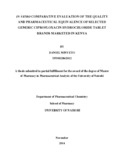In vitro comparative evaluation of the quality and pharmaceutical equivalence of selected generic ciprofloxacin hydrochloride tablet brands marketed in Kenya
Abstract
Introduction
Ciprofloxacin is a quinolone derivative antibiotic produced through structural modification by addition of the 7-piperazinyl group and a fluoride atom on the quinolone molecule. It has a broad spectrum of activity against both Gram-positive and Gram-negative bacteria. Because of this, it is used to treat a wide range of infections including urinary tract infections (UTIs), respiratory tract infection, skin and soft tissue infections and intra-abdominal infections. It is listed by the
World Health Organisation and by the Ministry of Health Kenya as an essential drug. The number of ciprofloxacin tablet brands on the Kenyan market has increased in the recent years from different sources and currently as of 2014 there are 88 different brands registered by the Pharmacy and Poisons Board (PPB). The increase in the number of generic drug products from multiple sources has placed people and prescribers in a position of selecting one from among several seemingly pharmaceutically equivalent products. This poses a challenge to the quality regulatory bodies leading to the influx of counterfeits and substandard products. Therefore there is need to subject the different brands of the same drug to physicochemical tests to determine their pharmaceutical equivalence and the possibility of substituting one brand for another while achieving the same therapeutic effect. Hence, this work was done to determine the physicochemical properties of 20 brands of film coated ciprofloxacin tablets.
Study objectives
The general objective of this study was to determine the quality of commercially available ciprofloxacin tablets in Nairobi, Kenya. This was in order to determine the appropriateness of their interchangeability.
Methodology
In this study, 20 brands of ciprofloxacin hydrochloride 500 mg tablets were subjected to the standard physicochemical tests of identification, uniformity of weight, hardness, disintegration, dissolution and assay to assess their physical and chemical equivalence. The tests were performed using official methods described in the British Pharmacopoeia and United States Pharmacopoeia.
Results
The results of the generics were compared to those of the innovator brand with reference to the official standards. The retention time of the major peak of the sample solutions of all ciprofloxacin brands corresponded to that of the standard solution, as obtained in the assay. The retention times of the samples ranged from 5.1 to 5.2 min and corresponded to the standard’s retention time at 5.2 min. All the brands complied with the compendial specification for uniformity of weight. And all the generics and the innovator brand were satisfactory for hardness. The disintegration time for the innovator brand and the generics ranged from 0.5-23.5 min. All the brands were satisfactory for the disintegration time since they all disintegrated in less than 30 min. There was no direct correlation between tablet hardness and disintegration time. All the brands of ciprofloxacin tablets passed as per the USP specification. The highest percentage content was obtained for brand C013 (104.58 %), while the least drug content was obtained for brand C018 (90.38 %). Brands C009, C010, C013, C014, C015 and C017 contained more active pharmaceutical ingredient than the innovator brand. At pH 1.2, most the brands of ciprofloxacin tablets studied released more than 85 % of the drug within 30 minutes except C004, C007 and C017, which had released only 82.48, 83.46 and 84.95%, respectively. At pH 4.5, most the brands released more that 85 % of ciprofloxacin except brand C013, C015 and C016, which released 73,73, 80.44 and 81.57 %, respectively within 30 min. All the products failed to release the specified amount of ciprofloxacin of 85 % by USP (2014) within 30 min.
Conclusion
From the similarity factor f2 calculation values, 10 of the 19 brands (52.63 %) can be said to be pharmaceutically equivalent with the innovator brand (IB), therefore they can be interchanged with the innovator brand.
Citation
Degree of Master of Pharmacy in Pharmaceutical Analysis,2014Publisher
University of Narobi

